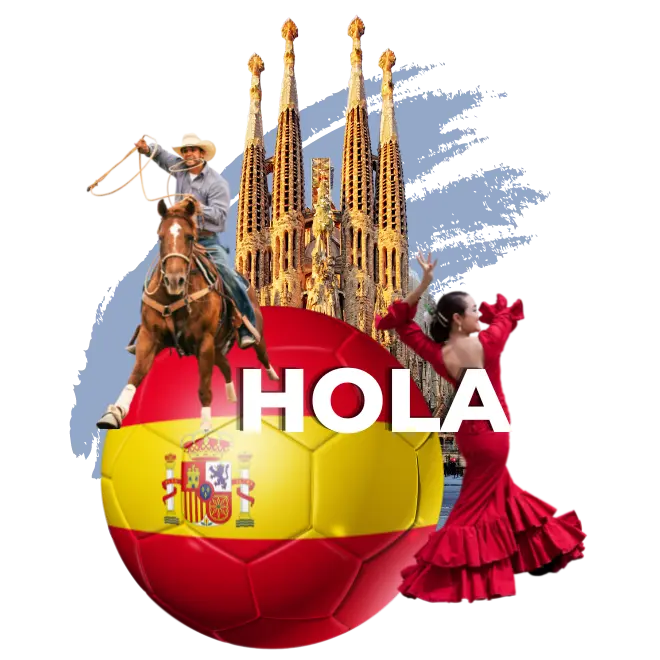SPANISH
Discover Langma's Spanish Language Program
Langma International offers Spanish language training for all CEFR levels, from A1 (Beginner) to C2 (Advanced). In order to provide students a comprehensive grasp of the language, we place a strong emphasis on four language skills in our Spanish language program: speaking, writing, listening, and reading. We also provide a thorough education of Spanish culture, literature, art, and much more, in addition to the language.
Langma International is an accredited official SIELE examination centre. FIDESCU has authorised us for the International Diploma of Spanish (DIE) examination. We are also an official exam centre for the International University of La Rioja (UNIR), Spain, in New Delhi.
Join Langma International for Spanish language learning and broaden your career prospects in Spain and other Spanish-language countries.
Spain (España)
Spain, situated in the southwestern part of Europe, has a population of around 48 million people. After the colonial era, it has been an influential power in international culture and politics. There are many UNESCO World Heritage sites in Spain, including the Alhambra in Granada, the Sagrada Familia in Barcelona, and the Mezquita of Córdoba. It is home to the extravagant La Tomatina festival, flamenco dancing that is famous worldwide, and artists like Picasso and Dalí, both born in Spain. Spain is the leading producer of olive oil in the world and is recognised for its dishes like paella and tapas.
Apart from Spanish, three regional languages have also been given the status of co-official languages in different areas of Spain. They are Castilian, Catalan, and Galician. If one learns Spanish, they can communicate with the Spaniards and also be a part of their cultural and historical heritage.
Spanish Culture (Cultura España)
Traditions, on one hand, and strong regional identities, on the other, have been the features of the Spanish cultural history. Spanish people are very friendly and helpful. They have a communal lifestyle, and family and shared experiences are the central ideas of their daily life. The tradition of using two surnames, one from each parent, is a form of family heritage, which is especially important in the culture of Spain. Spaniards love music and celebrations, and their national anthem, La Marcha Real, is widely known for being an instrumental piece that is unique in the world. To live in Spain means to live in a culture that, among other things, is centred on relationships, happiness, and genuineness.
Spanish Festivals (Festivales Españoles)
Numerous lively festivals are part of Spain's heritage. Locally and nationally, they showcase the identity of the people and are deeply rooted in history and religion. Valencia's Las Fallas (a fire-and-art festival), La Tomatina (a gigantic tomato fight in Buñol), San Fermín (the Running of the Bulls in Pamplona) and Semana Santa (a very solemn and spiritual Holy Week) are the main events that go on with a lot of pomp and show. Seville, during Feria de Abril, the Carnival of Santa Cruz de Tenerife, and La Mercè in Barcelona are unmissable celebrations.
Spanish Art and Paintings (Arte y pinturas españolas)
One of the most significant contributions to Western Art is its strong influence from Spanish Art and Artists. Some of the most famous Spanish artists in modern history, like Salvador Dalí, Pablo Picasso, and Francisco Goya, contributed significantly to Surrealism and Cubism. Velázquez and Zurbarán were the most famous painters of the Spanish Golden Age. Among the most famous Spanish art pieces are Guernica by Picasso, The Persistence of Memory by Salvador Dalí, The Third of May 1808 by Goya, The Burial of the Count of Orgaz by El Greco, and Las Meninas by Velázquez. The anti-war theme, the complexity of the structure, and the references to Spanish history and society are the main elements of their popularity.
Spanish Literature (Literatura española)
The most frequent references to Spanish literature are to one of the greatest literary works ever - the satirical novel Don Quixote by Miguel de Cervantes - and to the works by Spanish Golden Age authors such as Lope de Vega and Pedro Calderón de la Barca. García Márquez is the one who introduced and popularised the literary technique of magical realism, making it very vivid in One Hundred Years of Solitude. This is in contrast with Federico García Lorca, who is mainly known for his plays, e.g., The House of Bernarda Alba, which are considered some of the most influential works of modern literature.
Spanish Music (Música española)
Spanish music has been one long journey full of local traditions, diverse times, and ideas. Flamenco is a combination of vocals (cante), guitar (toque), and dance (baile), and it is a form of music and dance that came from the southern part of Spain and is the most widely recognised and loved. Besides, Sevillanas, Fandango, Sardana, and Jota are some of the forms through which different regions portray their distinctiveness. The instrumentation of Galicia's Bagpipe and the Spanish Zarzuela, a unique kind of Spanish operetta, are just some of the many components of Spain's musical heritage. The guitar compositions of Granados, Albéniz, and Manuel de Falla have been a great influence on the classical guitar, while Rosalía, Enrique Iglesias, and Alejandro Sanz are the ones who are taking Spanish music around the globe nowadays.
Spanish Dance (Danza Española)
Those who picture Spanish dance usually have in their mind Flamenco with its guitar music, rapid footwork, and flamboyant costumes. Flamenco is only one among several traditional dances of Spain, and each of them has its special personality and narrative. Sardana from Catalonia, Jota from Aragon, and Muñeira from Galicia are only a few examples of the story and style of dances that have formed the cultural heritage of the country through a rich Spanish mix.
Spanish Fashion (Moda Española)
Spain's fashion industry is very well known all over the world for its inventiveness, quality of work, and pioneering spirit. Paco Rabanne, Cristóbal Balenciaga, and Manolo have been the major trendsetters among world fashion trends. The Spanish style of fashion reaches the outside world through the leading brands like Zara, Mango, and Bershka. Modern designers draw inspiration from traditional Spanish dresses, such as the Mantilla and the Flamenco dress. World-famous fashion weeks in Barcelona and Madrid underline the major role of Spain in the global fashion industry.
Spanish Cuisine (Cocina Española)
One of the main reasons why Spanish food has become so popular globally is because of its rich flavours, wide range of dishes, and the fact that fresh ingredients are always used. No one can point to better dishes than paella, tapas, and gazpacho to exemplify the different flavours of every single area. Some of the ingredients used in Spanish cooking are olive oil, saffron, and jamón ibérico. In every area, there are local foods such as Basque pintxos, Andalusian seafood, and Crema Catalana from Catalonia.
Spanish Cinema (Cine español)
One of the main characteristics of Spanish movies is their imaginative, diverse plots. The three Spanish directors- Pedro Almodóvar, Luis Buñuel, and Alejandro Amenábar- are the major contributors in communicating the culture and emotions of Spain to people from all over the world. Some movies belong to different genres and periods, such as vintage dramas, thrillers, and comedies that tell not only of the past but also of Spain's spirit. Goya Awards are considered the Spanish equivalent of the Oscars and are given to those who have contributed the most to the Spanish film industry. Examples of movies like Pan’s Labyrinth or Volver, which have had a significant influence on the international film industry, are the best proof of the success of Spanish cinema.
Spanish Architecture (Arquitectura Española)
The architecture of Spain has artistically decorated pieces, from the old to the new. You can see the changes in Spain's architectural style through the years by comparing the works like the Alhambra, the Gothic cathedrals of León and Burgos, and the Sagrada Família by Antoni Gaudí in Barcelona. The architectural styles of the various regions have been the result of the influence of the Romans, Muslims, and Christians. With their newest projects, architects such as Santiago Calatrava continue this ancient heritage. Not only does Spanish architecture define the country's cities, but it also makes the dream of many people worldwide to come and experience its timeless charm and creativity.
The Spanish Language (La lengua española)
Spanish is a Romance language, and it is one of the top five most spoken languages in the world, with over 600 million speakers. Besides being one of the six official languages of the United Nations, it is the official language in 21 countries which are Spain, Equatorial Guinea, Mexico, Guatemala, Honduras, Nicaragua, Costa Rica, El Salvador, Panama, Cuba, Dominican Republic, Puerto Rico, Argentina, Bolivia, Paraguay, Chile, Colombia, Ecuador, Peru, Uruguay, and Venezuela.
The Spanish language was primarily known for its major contributions to the fields of art, literature, and philosophy. As a result, the number of job offers in Spanish-speaking countries has increased, and Spanish has become the preferred language for those seeking international career growth.
Pronunciation
Spanish is known to be a phonetic language, and therefore, it is an easy language to learn, as every letter of the Spanish alphabet is linked to a particular sound. Most of the sounds are very similar to those in the English language. The rules are very consistent and quite simple; thus, if you are aware of the spelling of a letter, you can quickly pronounce it. One may come across exceptions in foreign words, which usually keep their original spellings.
Word Stress
Spanish words, as a rule, have one syllable that is stressed much more than the others. The rule that words ending with n, s, or a vowel should be pronounced with the stress on the second-to-last syllable is beneficial. In the case of other endings, the last syllable is stressed. Whenever there is an accent mark, it is always that particular syllable that is stressed.
The Spanish Alphabet
The Spanish Alphabet consists of 27 letters, just like the English Alphabet, except that it is made up of one more letter, the ñ. Below are the names and the pronunciations of the letters of the Spanish alphabet.
Vowel Sounds
Spanish has the same five vowels as English: a, e, i, o, and u. Below is the Spanish vowels list along with their pronunciation and English and Spanish examples.
Consonant Sounds
While studying Spanish consonants, learners should keep in mind the following rules:
The letter c is pronounced with a soft th sound, as in 'Barcelona,' except before a, o, u, or a consonant, when it takes on a hard k sound, as in 'king.'
At the end of a word, the letter d is pronounced softly, similar to th, or may be nearly silent.
The Spanish letter j is pronounced as a strong, guttural sound.
The letter q is pronounced as a hard k sound.
The letter v is pronounced similarly to b, with the lips pressed together.
Spanish includes several letters not found in the English alphabet, such as ch, ll, and ñ.
Spanish Numbers
Below are Spanish numbers with their pronunciations to help learners practise.
Spanish Survival Phrases
The table below lists some Spanish phrases and words that form the first step in your journey of Spanish language learning. These Spanish language basics will help you get started with the language.









